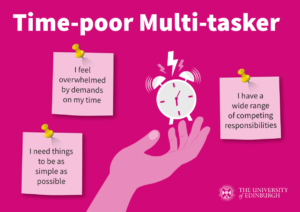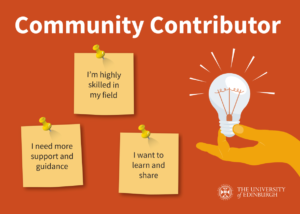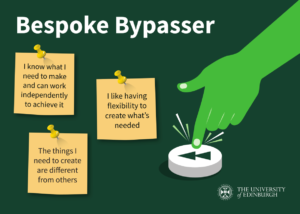Behavioural personas: how they helped us make content decisions for the Design System
We created behavioural personas to help us understand staff needs at the University of Edinburgh. We recently used these to help inform content decisions about the developing Design System.
Understand your users
Rule number 1 about any kind of content design you decide to embark on is to understand your users. Personas are a useful tool that can help you make decisions around a particular scenario or context. We’ve used behavioural personas to help us better understand our staff users, and to help answer questions about how our services, and in particular the Design System, can empower staff in the University to make great content.
Behaviour, not surface attributes
Personas are made by interviewing a wide range of users, and putting that information together in a way that expresses different kinds of wants, needs, frustrations and behaviours. We’ve used personas before at the University that have expressed a persona as a person in a particular role, with a name and a sketch of what they might look like. With this kind of persona, we form an impression of who that person is – we see surface attributes, like skin colour or gender, and make quick decisions about them that are based on unconcious bias.
We developed our personas further to create behavioural personas.
From personas to behaviour modes: Duncan Stephen
Behavioural personas help us to empathise with the staff we’re building our services for, and to understand the risks if we don’t help a particular behavioural group.
How personas help us make content decisions for the Design System
The idea behind the Design System is for staff to be able to access everything they need to make things in one place. We’ve worked hard to create content that answers the demands of the top tasks that surfaced from user research:
- knowledge around accessible, readable content to make a better experience for users
- access to an easy to use, central pattern library to access code, choose from components, and create a consistent experience
- self-serve from one place to save time and not seek information from the wrong place or person
- access consistent visual design/branding, so that materials are recognisable as UoE across all touchpoints
- access evidence base to persuade colleagues to make sound content decisions
When we mapped our personas to these top tasks, we could see a clear connection between the needs, wants and frustrations of the behavioural groups, and the task itself. It gave us a clearer picture of who we were making the Design System for.
We could also observe the absence of the bespoke bypasser persona from this quick mapping. This made us more determined to find out more about how the Design System could help this group.
Critical content
Some of us manage content that is seen and used by huge audiences. Our personas help us to see that some of us who are managing critical content have website responsibilities as part of our job, that that various factors including time pressure can make good content difficult.
We can also see that some bespoke content is created for audiences that are small, but very influential.
How can the Design System help us to turn our digital content around?
How can our Design System content help you?
We’ve thought very deeply about what kind of content we need in our Design System. This includes:
- Design Principles
- Brand values and materials
- Components
- Accessibility guidance
- Practical tools and resources for design
- Community contribution
Behavioural personas help us to understand how different kinds of users might approach the Design System.
For example:
 Time poor multi-tasker
Time poor multi-tasker
A time poor multi-tasker might not be interested in community contribution. They might be here to source an image for a web page.
How might we provide content that helps a time-poor multitasker make good content decisions in the short time they have?
 Community contributor
Community contributor
A community contributor is very interested in sharing knowledge.
They’re here for a component, but the thing they want isn’t here, and they’d like to collaborate to develop it.
How might we help a community contributor connect with the community?
 Bespoke bypasser
Bespoke bypasser
Bespoke bypassers tend to make, or get external help to make, their own thing.
How might we invite them to understand our design principles, and share them with external partners?
Further, how might we invite a bespoke bypasser to understand and share our guidance around accessibility?
 Institutional influencer
Institutional influencer
Institutional influencers are interested in consistency but work in siloed conditions with different funding models.
How might our design system help an institutional influencer to share materials that promote consistency and clarity of usage in teams across Schools?
Understanding risk
Personas help us to understand the context of our content, and the risks of not helping our personas to make better design decisions. What is the risk if we don’t help the:
- time-poor multitasker to make small but significant content changes?
- community contributor to share their knowledge and experience?
- bespoke bypasser to make digital content that upholds the reputation of the University?
- institutional influencer to achieve brand cohesion?
The best question: what can we achieve if we help this persona?
The time-poor multitasker gets the help they need with content.
The community contributor joins others in making our components and patterns better over time.
The bespoke bypasser uses the design system to help external developers make a site that coheres with our standards.
The institutional influencer sees their teams achieving consistency, not just in their area, but everywhere.
Keep learning
Personas are never finished. We’ll continue to learn about our community, adjusting our personas over time to maintain a true reflection of what we need, and what we do.


1 replies to “Behavioural personas: how they helped us make content decisions for the Design System”